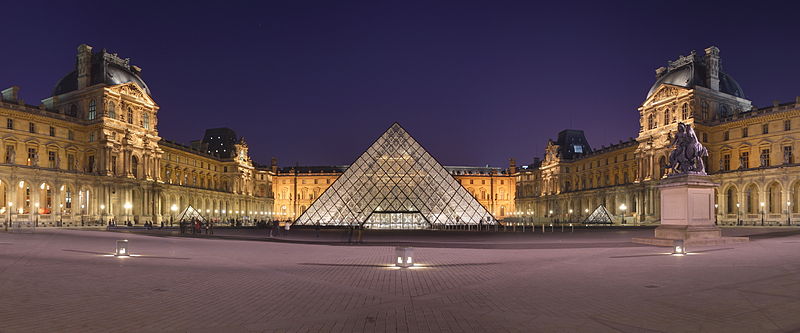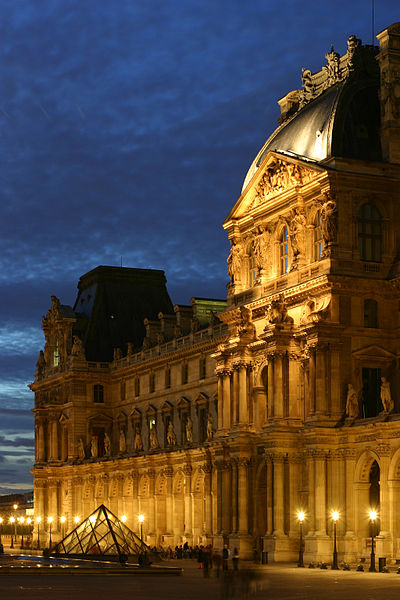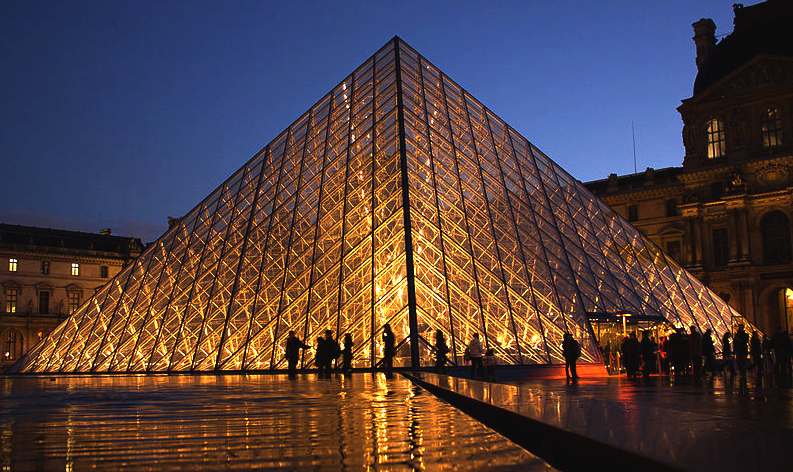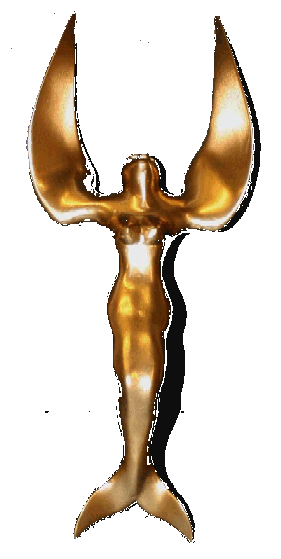|

The Musée du Louvre, or in English, the Louvre Museum or simply The Louvre,
is one of the world's largest museums, and also a historic monument. A central landmark of Paris, France, it is located on the Right Bank of the Seine in the 1st arrondissement (district). Nearly 35,000 objects from prehistory to the 21st century are exhibited over an area of 60,600 square metres (652,300 square feet). With more than 8 million visitors each year, the Louvre is the world's most visited museum.
The museum is housed in the Louvre Palace (Palais du Louvre) which began as a fortress built in the late 12th century under Philip II. Remnants of the fortress are visible in the basement of the museum. The building was extended many times to form the present Louvre Palace. In 1682, Louis XIV chose the Palace of Versailles for his household, leaving the Louvre primarily as a place to display the royal collection, including, from 1692, a collection of antique sculpture. In 1692, the building was occupied by the Académie des Inscriptions et Belles Lettres and the Académie Royale de Peinture et de Sculpture, which in 1699 held the first of a series of salons. The Académie remained at the Louvre for 100 years. During the French Revolution, the National Assembly decreed that the Louvre should be used as a museum, to display the nation's masterpieces.
The museum opened on 10 August 1793 with an exhibition of 537 paintings, the majority of the works being royal and confiscated church property. Because of structural problems with the building, the museum was closed in 1796 until 1801. The size of the collection increased under
Napoleon and the museum was renamed the Musée Napoléon. After the defeat of Napoleon at Waterloo, many works seized by his armies were returned to their original owners. The collection was further increased during the reigns of Louis XVIII and Charles X, and during the Second French Empire the museum gained 20,000 pieces. Holdings have grown steadily through donations and gifts since the Third Republic. As of 2008, the collection is divided among eight curatorial departments: Egyptian Antiquities; Near Eastern Antiquities; Greek, Etruscan, and Roman Antiquities; Islamic Art; Sculpture; Decorative Arts; Paintings; Prints and Drawings.
21st
CENTURY
The Musée du Louvre contains more than 380,000 objects and displays 35,000 works of art in eight curatorial departments with more than 60,600 square metres (652,000 sq ft) dedicated to the permanent collection. The Louvre exhibits sculptures, objets d'art, paintings, drawings, and archaeological finds. It is the world's most visited museum, averaging 15,000 visitors per day, 65 percent of whom are foreign tourists.
After architects Mario Bellini and Rudy Ricciotti had won an international competition to create its new galleries for Islamic art, the new 3,000 sq m pavilion eventually opened in 2012, consisting of ground- and lower-ground-level interior spaces topped by a golden, undulating roof (fashioned from almost 9,000 steel tubes that form an interior web) that seems to float within the neo-Classical Visconti Courtyard in the middle of the Louvre’s south wing. The galleries, which the museum had initially hoped to open by 2009, represent the first major architectural intervention at the Louvre since the addition of I.M. Pei’s glass pyramid in 1989.

ADMINISTRATION
Leonardo da Vinci's
Mona Lisa is the Louvre's most popular attraction.
The Louvre is owned by the French government; however, since the 1990s it has become more independent. Since 2003, the museum has been required to generate funds for projects. By 2006, government funds had dipped from 75 percent of the total budget to 62 percent. As the Louvre became a point of interest in the book The Da Vinci Code and the 2006 film based on the book, the museum earned $2.5 million by allowing filming in its galleries. In 2008, the French government provided $180 million of the Louvre's yearly $350 million budget; the remainder came from private contributions and ticket sales.
The Louvre employs a staff of 2,000 led by Director Jean-Luc Martinez, who reports to the French Ministry of Culture and Communications. Martinez replaced Henri Loyrette in April 2013. Under Loyrette, who replaced Pierre Rosenberg in 2001, the Louvre has undergone policy changes that allow it to lend and borrow more works than before. In 2006, it loaned 1,300 works, which enabled it to borrow more foreign works. From 2006 to 2009, the Louvre lent artwork to the High Museum of Art in Atlanta, Georgia, and received a $6.9 million payment to be used for renovations. In 2012, the Louvre and the Fine Arts Museums of San Francisco announced a five-year collaboration on exhibitions, publications, art conservation and educational programming. The €98.5m expansion of the Islamic Art galleries in 2012 received state funding of €31 million, as well as €17 million from the Alwaleed Bin Talal Foundation founded by the eponymous Saudi prince. The republic of Azerbaijan, the Emir of Kuwait, the Sultan of Oman and King Mohammed VI of Morocco donated in total €26 million. In addition, the opening of the Louvre Abu Dhabi is supposed to provide €400 million over the course of 30 years for its use of the museum’s prestigious brand. Loyrette has tried to improve weak parts of the collection through income generated from loans of art and by guaranteeing that "20% of admissions receipts will be taken annually for acquisitions". He has more administrative independence for the museum and achieved 90 percent of galleries to be open daily, as opposed to 80 percent previously. He oversaw the creation of extended hours and free admission on Friday nights and an increase in the acquisition budget to $36 million from $4.5 million.
SATELLITE MUSEUMS
Louvre-Lens
In 2004, French officials decided to build a satellite museum on the site of an abandoned coal pit in the former mining town of Lens to relieve the crowded Paris Louvre, increase total museum visits, and improve the industrial north's economy. Six cities were considered for the project: Amiens, Arras, Boulogne-sur-Mer, Calais, Lens, and Valenciennes. In 2004, French Prime Minister Jean-Pierre Raffarin chose Lens to be the site of the new building, called Le Louvre-Lens. Japanese architects SANAA were selected to design the Lens project in 2005. Museum officials predicted that the new building, capable of receiving about 600 works of art, would attract up to 500,000 visitors a year when it opened in 2012.
Abu Dhabi
In March 2007, the Louvre announced that a Louvre museum would be completed by 2012 in Abu Dhabi. A 30-year agreement, signed by French Culture Minister Renaud Donnedieu de Vabres and Sheik Sultan bin Tahnoon Al Nahyan, will establish the museum in downtown Abu Dhabi in exchange for €832,000,000 (US$1.3 billion). The Louvre Abu Dhabi, designed by the French architect Jean Nouvel and the engineering firm of Buro Happold, will occupy 24,000 square metres (260,000 sq ft) and will be covered by a roof shaped like a flying saucer. France agreed to rotate between 200 and 300 artworks during a 10-year period; to provide management expertise; and to provide four temporary exhibitions a year for 15 years. The art will come from multiple museums, including the Louvre, the Georges Pompidou Centre, the Musée d'Orsay, Versailles, the Musée Guimet, the Musée Rodin, and the Musée du quai Branly.
Controversies
The Louvre is involved in controversies that surround cultural property seized under Napoleon I, as well as during World War II by the
Nazis. After Nazi occupation, 61,233 articles on more than 150,000 seized artworks returned to France and were assigned to the Office des Biens Privés. In 1949, it entrusted 2130 remaining unclaimed pieces (including 1001 paintings) to the Direction des Musées de France in order to keep them under appropriate conditions of conservation until their restitution and meanwhile classified them as MNRs (Musees Nationaux Recuperation or, in English, the National Museums of Recovered Artwork). Some 10% to 35% of the pieces are believed to come from Jewish spoliations and until the identification of their rightful owners, which declined at the end of the 1960s, they are registered indefinitely on separate inventories from the museum's collections.
They were exhibited in 1946 and shown all together to the public during four years (1950–1954) in order to allow rightful claimants to identify their properties, then stored or displayed, according to their interest, in several French museums including the Louvre. From 1951 to 1965, about 37 pieces were restituted. Since November 1996, the partly illustrated catalogue of 1947–1949 has been accessible online and completed. In 1997, Prime Minister Alain Juppé initiated the Mattéoli Commission, headed by Jean Mattéoli, to investigate the matter and according to the government, the Louvre is in charge of 678 pieces of artwork still unclaimed by their rightful owners. During the late 1990s, the comparison of the American war archives, which had not been done before, with the French and German ones as well as two court cases which finally settled some of the heirs' rights (Gentili di Giuseppe and Rosenberg families) allowed more accurate investigations. Since 1996, the restitutions, according sometimes to less formal criteria, concerned 47 more pieces (26 paintings, with 6 from the Louvre including a then displayed Tiepolo), until the last claims of French owners and their heirs ended again in 2006.
According to Serge Klarsfeld, since the now complete and constant publicity which the artworks got in 1996, the majority of the French Jewish community is nevertheless in favour of the return to the normal French civil rule of prescription acquisitive of any unclaimed good after another long period of time and consequently to their ultimate integration into the common French heritage instead of their transfer to foreign institutions like during World War II.
Napoleon's campaigns acquired Italian pieces by treaties, as war reparations, and Northern European pieces as spoils as well as some antiquities excavated in Egypt, though the vast majority of the latter were seized as war reparations by the British army and are now part of collections of the British Museum. On the other hand, the Dendera zodiac is, like the Rosetta stone, claimed by Egypt even though it was acquired in 1821, before the Egyptian Anti-export legislation of 1835. The Louvre administration has thus argued in favor of retaining this item despite requests by Egypt for its return. The museum participates too in arbitration sessions held via UNESCO's Committee for Promoting the Return of Cultural Property to Its Countries of Origin. The museum consequently returned in 2009 five Egyptian fragments of frescoes (30 cm x 15 cm each) whose existence of the tomb of origin had only been brought to the authorities attention in 2008, eight to five years after their good-faith acquisition by the museum from two private collections and after the necessary respect of the procedure of déclassement from French public collections before the Commission scientifique nationale des collections des musées de France.

CONTACTS
Musée du Louvre
The Louvre is open every day (except Tuesday) from 9 a.m. to 6 p.m.
Night opening until 9:45 p.m. on Wednesdays and Fridays
Closed on the following holidays: January 1, May 1, December 25
Musée du Louvre, 75058 Paris - France
Métro: Palais-Royal Musée du Louvre (lines 1 and 7)
Tel. +33 (0)1 40 20 53 17 (except Tuesday)
info@louvre.fr
Membership Center (Espace Adhésion) at the Louvre
Located between the Pyramid and the Galerie du Carrousel, allée du Grand Louvre.
Open daily (except Tuesday) from 9 a.m. to 5 p.m., and 9 p.m. on Wednesdays and Fridays.
Closed the first Sunday of the month from January to August.
Tel. + 33 (0)1 40 20 51 04
adhesion.louvrejeunes@louvre.fr
Visitors with disabilities
Tel. +33 (0)1 40 20 59 90
handicap@louvre.fr
Alternatively you can contact:
Information desk: +33 (0)1 40 20 53 17
Switchboard: +33 (0)1 40 20 50 50
LINKS
http://en.wikipedia.org/wiki/The_Louvre
http://www.louvre.fr/en
http://www.tate.org.uk/visit/tate-modern/contact
http://www.tate.org.uk/homepage
http://www.tate.org.uk/art
http://www.tate.org.uk/whats-on
http://www.tate.org.uk/research
http://shop.tate.org.uk/
http://www.tate.org.uk/about/who-we-are/charitable-status
http://www.legislation.gov.uk/ukpga/1992/44/contents

|



